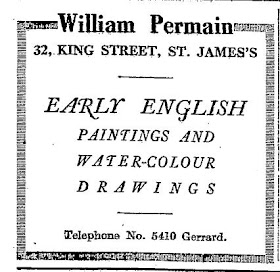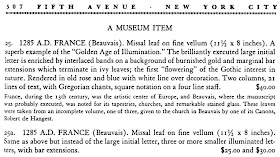As is well known, it was in the collection of Arthur Brölemann, which descended to his great-granddaughter Mme Etienne Mallet (the line of descent is explained in a later blog-post), and was sold at Sotheby's in 1926; then it disappears from sight, until it reappears as single leaves.
Even Christopher de Hamel, who has always had a lively interest in provenance (helped by access to confidential records of buyers and sellers in his 25 years at Sotheby's), and who catalogued several of the Missal's leaves both during those years and since, appears not to have been able to bridge the gap between its appearance at Sotheby's and its being cut up. Describing a Beauvais Missal leaf in his recent Gilding the Lilly catalogue [1], he concludes the provenance section simply with:
"... Madame Etienne Mallet; her sale, Sotheby's 5 May 1926, lot 161, to Permain; Otto F. Ege (1888-1951), who cut it up."An obvious first step is to identify "Permain", and a quick Google search provides a clue: a William Permain was a prominent London art dealer who died in 1910:
 |
| The Times, 6 May 1910 |
William's business continued to trade under his name after his death, as shown by this advertisement, placed more than a year later:
 |
| The Times, 20 October 1911 |
Other manuscripts at the 1926 Mallet sale that were bought by Permain (a full list is provided in a forthcoming blog-post) include:
- Claremont, CA, Scripps College, Denison Library, Perkins 3
- Washington, D.C., Library of Congress, Rosenwald MS 5
Both of these were later owned by, and thus presumably bought on behalf of, William Randolph Hearst (1863–1951) the newspaper tycoon, perhaps best known today for the movie Citizen Kane, and for Hearst Castle on the California coast:
Anyone who has visited the Castle (which I can highly recommend, having been at least three times since 1990) will be aware that Hearst was very keen on Antique and medieval objects, seemly buying entire Spanish monasteries and shipping them to California.
A web search combining the names of Permain and Hearst produce a considerable number of results, that show Permain bought all kinds of art object for Hearst, especially silver, including this Viking neck-ring now in Baltimore:
Indeed, such a search also produces a photograph of Permain himself, taken the year after the Mallet sale, in a story in Time Magazine about the sale of Hearst silver at Sotheby's:
Anyone who has visited the Castle (which I can highly recommend, having been at least three times since 1990) will be aware that Hearst was very keen on Antique and medieval objects, seemly buying entire Spanish monasteries and shipping them to California.
A web search combining the names of Permain and Hearst produce a considerable number of results, that show Permain bought all kinds of art object for Hearst, especially silver, including this Viking neck-ring now in Baltimore:
 |
| Source |
If this is the Permain who bought the Beauvais Missal at the Mallet sale, as seems certain; and he was acting for Hearst, as seems very probable; then it ought to be possible to identify the Missal among the records of the Hearst collection. And indeed it is.
Due to losses suffered in the Great Depression, Hearst began to sell artworks from 1937 onwards. A thick catalogue of items from his collection was printed by "Gimbel Brothers, New York, in cooperation with Saks Fifth Avenue, under the direction of Hammer Galleries" [2], with a copyright date of 1941:
On p.223 of the 1941 Gimbel-Saks-Hammer catalogue, among a handful of other illuminated manuscripts, is this:
The title, including the spelling of "Beluacensem"; the number of leaves, miniatures, and large initials; the binding; the dimensions; and the date, are all clearly copied from the 1926 Mallet catalogue:
Searching online for a connection between Permain and Hearst leads to a PDF entitled "The William Randolph
Hearst Archive: An Emerging Opportunity for Digital Art Research and
Scholarship", by Prof. Catherine Larkin, of Long Island University (which houses the archive), in which she states that Permain was "Hearst's primary agent in London for the better part of the first half of the 20th century". Searching the Archive online I was able to locate a reference to the Missal and contacted Prof. Larkin, who very kindly provided scans of the relevant documents for me.
One document consists of a two-page typescript description of the Missal, copied directly from the 1926 catalogue. The other, a Sales Record card, is more informative:
 |
| Image: Courtesy
of the B. Davis Schwartz Memorial Library, Long Island University [click image for larger version] |
It is dated 31 May 1926, a few weeks after the Mallet auction (perhaps payments were processed on the last day of each month?), and records that William Permain sold the manuscript to Hearst for $4720.26: this is explained in the right-hand column as £970 converted at a currency exchange-rate of 4.86⅝ dollars to the pound sterling.
£970 was the hammer-price at the auction; the fact that Permain has not added a commission (10% would have been normal) suggests that he was being paid on a retainer instead. (Some collectors prefer to operate this way, as it removes from the dealer any incentive to buy items at artificially inflated prices, for example by arranging for a colleague to bid against him, beyond what an item is really worth).
In red on the card, below the acquisition notes in blue, is a record of the fact that the manuscript was sold to Gimbel Bros. on Oct. 30, 1942, for $1000. So although the Gimbel catalogue reproduced above was apparently published in 1941, it seems that Gimbel Bros. did not have to pay Hearst until they found a buyer for each item.
Christopher de Hamel has observed that Ege often worked in partnership with the New York book-dealer Philip C. Duschnes, stating that "By the end of his life Ege had virtually gone into partnership with Duschnes" [3] : they often seem to have divided a newly-broken medieval manuscript between them. But Scott Gwara, while acknowledging this close business relationship, suggests that the relationship is unclear -- "Ege's partnership with Duschnes remains undefined" -- and suggests that Ege would not have broken-up a manuscript that was substantially complete: "rather than cutting up intact manuscripts, such as the sumptuous Beauvais Missal ... Ege may well have bought sizeable fragments of them from Duschnes" [4].
It seems very likely that Duschnes bought the Beauvais Missal in New York from the Gimbel-Saks-Hammer catalogue described above, extracted a number of leaves to sell himself, and sold the remainder of the manuscript to Ege, who, based in the midwest, would not be in direct competition with him for his East Coast clients. Certainly the first recorded appearance thus-far identified of any cut-out leaves from the Missal are as nos.25 and 25a in Duschnes's Catalog 54, 101 Original Leaves & Sets of Leaves from Medieval manuscripts ... 1150 A.D.–1933 A.D ..., which is undated, but was issued in October 1942 according to de Hamel [5]; this date is corroborated by the fact that the Berkeley copy was stamped as "Received" on "Nov 14 1942":
Duschnes was offering an unspecified number of leaves in this catalogue; his descriptions represent one or more leaves each with a "brilliantly executed large initial" at $40, and at least three further leaves "Same as the above but instead of the large initial letter, three or more smaller illuminated letters", at $25 and $30:
It seems highly improbable that Duschnes could have included leaves from the Missal as early as October 1942, the same month it was sold to Gimbel Bros. from the Hearst collection, unless he had bought it directly from Gimbel's in New York, rather than with Ege in Ohio as an intermediary.
Duschnes certainly had enough of the Beauvais Missal to be still selling leaves, including some or all of the calendar, at four different price-points ($20, $30, $35 and $40), in his Catalogue 74, in 1946:
We are probably safe therefore, to treat Duschnes, rather than Ege, as "the villain of the piece" in the story of the cutting-up of the Beauvais Missal, and Gwara is probably correct to suggest that "Duschnes may well have been the éminence grise behind Ege's business".
Notes:
[1] Gilding the Lilly: a Hundred Medieval and Illuminated Manuscripts in the Lilly Library (2010), p.76.
[2] Saks Fifth Avenue had opened in 1924, the year after Saks & Co. merged with Gimbel Brothers Inc. For the sale of Hearst property Gimbel's allocated over 100,00 square feet of floor space while Saks devoted a gallery to Hearst's paintings. The Hammer Galleries had been founded by Victor Hammer, younger brother of Armand Hammer. For more on the display and sale of the Hearst collection see "Hearst Art Exhibited in Department Stores", Art Digest, March 1, 1940, p.21; "Hearst Collection", Art Digest, January 1, 1941, p.23; and "Mr Hearst Goes to Gimbel's", Architectural Forum March 1941, p. supp. 8.
[3] Cutting Up Manuscripts for Pleasure and Profit (Charlottesville, 1996), p.18.
[4] Otto Ege's Manuscripts (Cayce, SC, 2013), p.31.
[5] Disbound and Dispersed: The Leaf Book Considered (Chicago, 2005), p.19











Hello Peter,
ReplyDeleteI think that three leaves from the same Missal were sold by Christie's in 2013 (sale 2706): http://www.christies.com/lotfinder/books-manuscripts/missal-beauvais-missal-three-leaves-in-5662791-details.aspx
Best,
Eduard Frunzeanu
Equipex Biblissima
Dear Peter, Many thanks for the helpful steer that William Permain's dealership was continued under the same name after his death by his son. I've done a little more digging in relation to my current research and have discovered that William Randolph Hearst's agent in London was not Thomas Permain but his younger brother Ernest, so it will have been Ernest who bought the Beauvais Missal. Thomas ran his own fine art dealership at 170 Piccadilly but went bankrupt in 1922, while Ernest maintained the dealership of William Permain on King Street and prospered, largely through the connection with Hearst. There are lots of newspaper reports that make the link explicit, including after the death of Thomas Permain in 1928. I'm aware that you posted this particular blog nine years ago, but I hope that the update may still be of interest. John Hilary.
ReplyDeleteInteresting that William Richard Targett Permain's obituary records him as a native of Liverpool. I've been researching him as part of genealogical research (which is how I stumbled across your post) as he's my great-uncle removed by some generations, and he was baptised in 1840 in Wonston, Hampshire, which is where his family was based. Censuses also show his birth place as Hampshire. From a glance over available newspapers from the time, it looks like he was a grocer in Hampshire until he went bankrupt in the early 1860s, perhaps prompting the move to Liverpool and the career change? I wonder why people thought he was a native of Liverpool.
ReplyDeleteThank you for sharing, even though I know this isn't the point of your post!